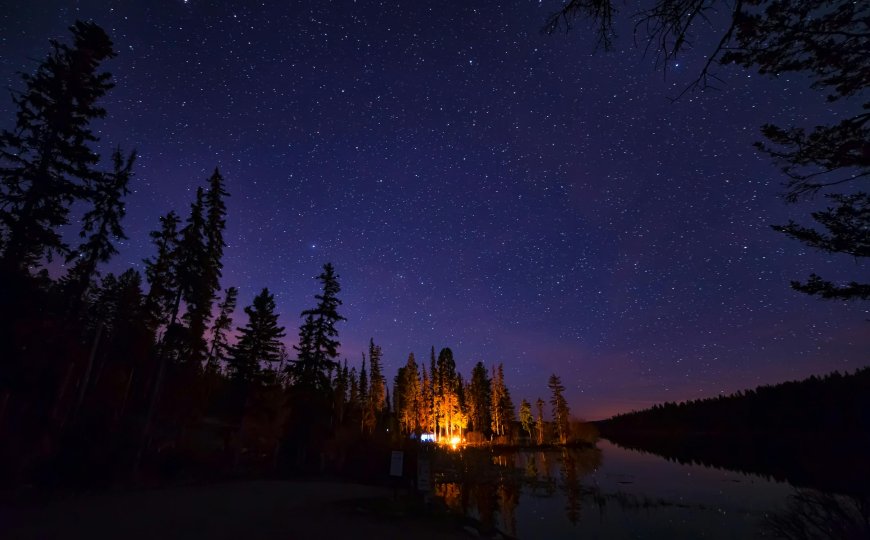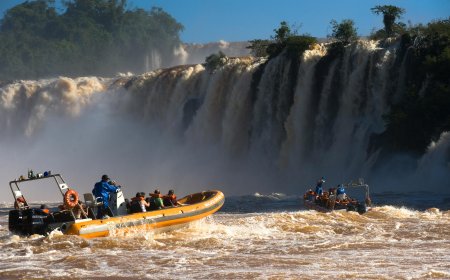How to camp safely in the wilderness
To camp safely in the wilderness, start with thorough planning and preparation. Look for a campsite with access to clean water and close to green spaces, and avoid low-lying areas where water may accumulate. Equip yourself with essential camping gear such as a sturdy tent and comfortable bedding, and make sure to bring emergency supplies like candles and flashlights. Before sleeping, ensure that campfires are completely extinguished and store food securely away from wildlife. Follow local guidelines and update your plans according to weather and environmental conditions around you.

To camp safely in the wilderness, start with thorough planning and preparation. Look for a campsite with access to clean water and close to green spaces, and avoid low-lying areas where water may accumulate. Equip yourself with essential camping gear such as a sturdy tent and comfortable bedding, and make sure to bring emergency supplies like candles and flashlights. Before sleeping, ensure that campfires are completely extinguished and store food securely away from wildlife. Follow local guidelines and update your plans according to weather and environmental conditions around you.
How to camp safely in the wilderness
Camping in the wilderness requires careful planning and continuous effort to ensure safety and enjoy the experience in a fun and secure manner. It starts with choosing the right location, preferably an open area away from flowing water to avoid the risk of flooding and water contamination. It's also important to look for a site with shade and access to clean water.
Camping equipment is crucial for these trips, providing peace of mind and safety. Make sure to have a sturdy tent suitable for the wilderness environment, as well as comfortable sleeping gear with moisture and cold insulation. Additionally, emergency equipment such as candles, flashlights, and thermal blankets should be brought along in case of emergencies.
Avoid fragile fires in the wilderness, and make sure to extinguish them completely before sleeping or leaving the site. Food should be stored securely away from the campsite to avoid attracting wildlife, and follow the safety guidelines specific to camping in the wilderness.
Stay vigilant to the surrounding conditions and local guidance, updating your plans according to changes in weather and the environment. By following these guidelines and preparing well, you can enjoy camping in the wilderness safely and comfortably.
Choosing the perfect campsite for your wilderness camping trip
When it comes to camping in the wilderness, choosing the perfect location is crucial for a comfortable and safe experience. The selected site should meet your needs and provide suitable conditions for staying in the wild.
First and foremost, safety and protection from external factors should be considered. Look for a location away from high places that may be prone to water contamination during heavy rains. Also, avoid low-lying areas where water may accumulate or be prone to flooding.
Secondly, look for a site that provides natural shade such as trees or large rocks, which can be beneficial in case of unexpected weather conditions like heavy rain or scorching sun.
Thirdly, consider the availability of clean water near the chosen site, whether it's from a lake, drinkable river, or even a water well. Access to clean water is essential for drinking, cooking, and cleaning.
Fourthly, also consider the distance between the camping site and any areas where wildlife may be present. It's important to avoid areas that may be home to predatory animals such as bears or snakes.
Finally, the site should be visible and known to potential campers, while avoiding staying in restricted or protected areas to preserve the wilderness environment.
By carefully choosing the perfect location, you can enjoy wilderness camping safely and comfortably, ensuring that you select a site that meets your needs and provides you with comfort and safety.
Important preparations before camping in the wilderness
Before embarking on a wilderness camping experience, there are several important preparations that must be done to ensure your safety and comfort during the trip. Let's go over these preparations in detail:
1. Site Study: Before traveling to the wilderness, carefully study the chosen site. Gather information about the expected weather, terrain, and activities available in the area.
2. Equipment Preparation: Make sure you have gathered and inspected all necessary equipment for camping in the wilderness, such as tents, sleeping bags, flashlights, and cooking utensils.
3. Water and Food: Carry an adequate amount of clean water and non-perishable food that can be consumed without cooking. Also, have a plan for cleaning utensils and securely storing waste.
4. Emergency and First Aid: Carry a comprehensive first aid kit including bandages, antiseptics, allergy medications, and other necessary supplies to deal with health emergencies.
5. Communication: Ensure there is a way to communicate with the outside world in case of emergencies, whether through a mobile phone or emergency communication device.
6. Plan Update: Update your trip plan based on the latest available information about the weather and surrounding conditions.
7. Site Cleanup: Before leaving the site, make sure to clean it thoroughly and leave it as you found it, ensuring to extinguish fires and securely store waste.
By completing these important preparations, you can enjoy wilderness camping safely and comfortably, making the most of your enjoyable time in nature.
The necessary camping equipment for a safe experience in the wilderness
When planning for a wilderness camping experience, you should have the perfect camping equipment to ensure your comfort and safety during your stay in nature. Here is a list of essential equipment that should be part of your gear:
1. Tent: Choose a sturdy tent that is wind and rain resistant, and is large enough to accommodate you and other gear you may need.
2. Sleeping and Comfort: Consider selecting the appropriate sleeping gear, whether it's a comfortable air mattress or an insulated sleeping bag to maintain warmth on cold nights.
3. Cooking Equipment: Carry a portable gas stove or a small wood-burning stove, along with a cooking pot, utensils, and basic cooking tools.
4. Lighting: Equip yourself with a powerful handheld flashlight and a LED headlamp to provide illumination in the dark and during nighttime activities.
5. First Aid Kit: Carry a first aid kit containing bandages, antiseptics, and essential first aid medications.
6. Transportation and Navigation Tools: Bring a local map and compass, and you can also use mobile phone apps for navigation and location tracking.
7. Emergency Supplies: Consider carrying an emergency blanket, candles, water purifier, and other necessary items in case of emergencies.
8. Personal Camping Gear: Bring personal sleeping items such as sleeping pads and extra blankets, as well as cold and hot weather clothing.
By using this essential equipment, you will be able to enjoy a safe and comfortable wilderness camping experience, with the confidence that you are prepared to face any challenges that may arise during the trip.
Wildfire prevention techniques while camping in the wilderness
Wildfire prevention techniques while camping in the wilderness are crucial for personal safety and environmental preservation. Here are some techniques and measures that can be taken to prevent wildfires while camping in the wilderness:
1. Choose a safe campsite: Select a location that is away from dry trees and dense shrubs, and avoid areas with dry, flammable grasses. The site should be flat and free from flammable objects.
2. Prepare a designated fire area: Establish a designated fire area away from dry plants and trees. Always use a ring of rocks or stones to delineate the boundaries of the fire.
3. Light the fire carefully: Use suitable fuel such as dry wood and natural charcoal to light the fire, and avoid using quickly ignitable fuels such as gasoline.
4. Continuously monitor the fire: Never leave the fire unattended at any time. Ensure there is a responsible person monitoring the fire and ensuring it remains under control.
5. Properly extinguish the fire: Completely extinguish the fire before sleeping or leaving the site. Pour water over the fire and stir the ashes to ensure it is completely extinguished.
6. Avoid open fires: Avoid lighting open fires in strong winds or in particularly dry areas, where the fire can spread rapidly.
7. Report wildfires: In case of witnessing an uncontrolled wildfire, immediately contact local firefighting teams and report the situation for assistance.
By following these techniques and measures, you can enjoy a safe camping experience in the wilderness while also preserving the natural environment from the risk of wildfires.
How to deal with wildlife while camping in the wilderness
When camping in the wilderness, you may encounter challenges related to dealing with wildlife, but steps can be taken to handle these situations safely and responsibly. Here are some tips for dealing with wildlife while camping in the wilderness:
1. Familiarize yourself with local animals: Before traveling, research the animals present in the area where you plan to camp. Learn about the types of animals that may be present and their natural behaviors.
2. Approach with caution: When encountering a wild animal, maintain a safe distance and do not approach it. Avoid actions that may scare the animals, such as screaming or running.
3. Securely store food: Keep food and waste stored in tightly sealed containers and away from the camp area to avoid attracting animals in search of food.
4. Avoid feeding wildlife: Refrain from feeding wild animals or leaving food scraps around the campsite, as these actions can alter the animals' behavior and make them reliant on humans for food.
5. Be prepared for emergencies: Carry emergency equipment such as emergency whistles and bear spray in case of encountering a wild animal that attacks.
6. Minimize noise: Avoid making loud noises or excessive noise, as this can startle animals and disrupt their behavior.
7. Communicate with local authorities: In case of a problem with a wild animal, communicate with local authorities or national parks for assistance and guidance.
By taking these precautions and guidelines, you can deal with wildlife in a safe and responsible manner, and enjoy camping in the wilderness safely.
Steps to stay safe while camping in the wilderness
Staying safe while camping in the wilderness requires taking several steps and precautions to ensure personal safety and preserve the natural environment. Here are some steps that can be taken to achieve this goal:
1. Preparations: Plan your trip carefully in advance, and make sure to prepare a comprehensive list of equipment and supplies necessary for camping in the wilderness.
2. Choose the location carefully: Select a safe camping site away from steep slopes, dead trees, and flowing water, and avoid areas known for the presence of predatory animals.
3. Light the fire cautiously: Start a fire in a designated area away from dry plants, and make sure to extinguish it completely before sleeping or leaving the site.
4. Store food safely: Keep food in tightly sealed containers away from the camping area, and avoid leaving food waste around the site.
5. Monitor the weather: Keep an eye on weather forecasts and conditions, and make sure to equip yourself with the necessary clothing and equipment to face any sudden changes.
6. Avoid wild animals: Avoid approaching wild animals and maintain a safe distance, and do not attempt to approach or feed them.
7. Contact local authorities: In case of any problems or emergencies, contact local authorities or rescue teams for necessary assistance.
8. Team awareness: Discuss safety rules and precautions with your team or group members before starting the trip, and make sure everyone understands and follows these guidelines.
By following these steps, you can enjoy camping in the wilderness safely and comfortably while preserving your safety and the safety of the surrounding environment.
Summary
To ensure safe camping in the wilderness, campers must follow several important steps, starting from choosing a suitable site away from steep areas and dry vegetation, to igniting a fire in a designated area and monitoring it closely at all times. Additionally, storing food and waste away from the camping site to avoid attracting wild animals, along with cautiously avoiding wild animals and refraining from direct interaction with them, are crucial. It is also essential to communicate with local authorities for necessary information about the surrounding environment and assistance in case of any emergencies or problems during the camping period.
sources
1. Ministry of Tourism and Travel Website Here, you can find articles and tips about safety in camping in the prairies and wilderness areas.
2. Wilderness Safety Center This website provides articles and resources on how to camp safely in the prairies and how to deal with risks.
3. National Wilderness Preservation Association Website This website offers tips on staying safe while camping in the prairies and ensuring preparedness for wilderness conditions.
4. Prairie Safety Center Website This website provides articles and educational videos on how to camp safely and take necessary precautions in the prairies.
What's Your Reaction?

















































































































